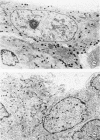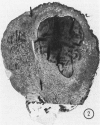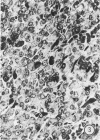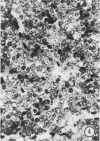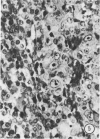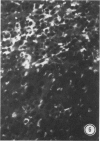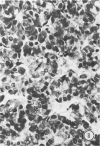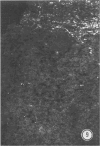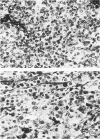Abstract
Twenty-three spontaneous pituitary tumors in 58 rats of Wistar/Furth/Ico strain were studied. The incidence is 38% in rats older than 10 months; it rises with age, with a maximum at 28-32 months (68.7%) and is higher in females (71.4%) than in males (35%) over 17 months. Light-microscopic and immunocytochemical studies revealed 20 prolactinomas in 19 rats (19/58, 32.7%) and 3 spongiocytic nonimmunostaining adenomas (3/58, 5.2%). The prolactinoma is often hemorrhagic. The cells, often arranged in sheets and agranular, are mostly positive with anti-rat prolactin (rPRL) serum. They have few polymorph granules and a well-developed rough endoplasmic reticulum. In the spongiocytic adenoma, the cells are arranged in cords. Their cytoplasm is slightly vacuolated. In prolactinoma-bearing rats, the mean plasma PRL value was 213 +/- 72.5 microgram/1 (SEM) (N = 15 +/- 1.8 microgram/1 [SEM]). A linear correlation was found between the logarithm of the tumoral pituitary weight or of the tumor size and the logarithm of the prolactinemia. Because of the analogies between these rat prolactinomas and 57 human prolactinomas, the Wistar/Furth/Ico rat strain is considered as a good animal model.
Full text
PDF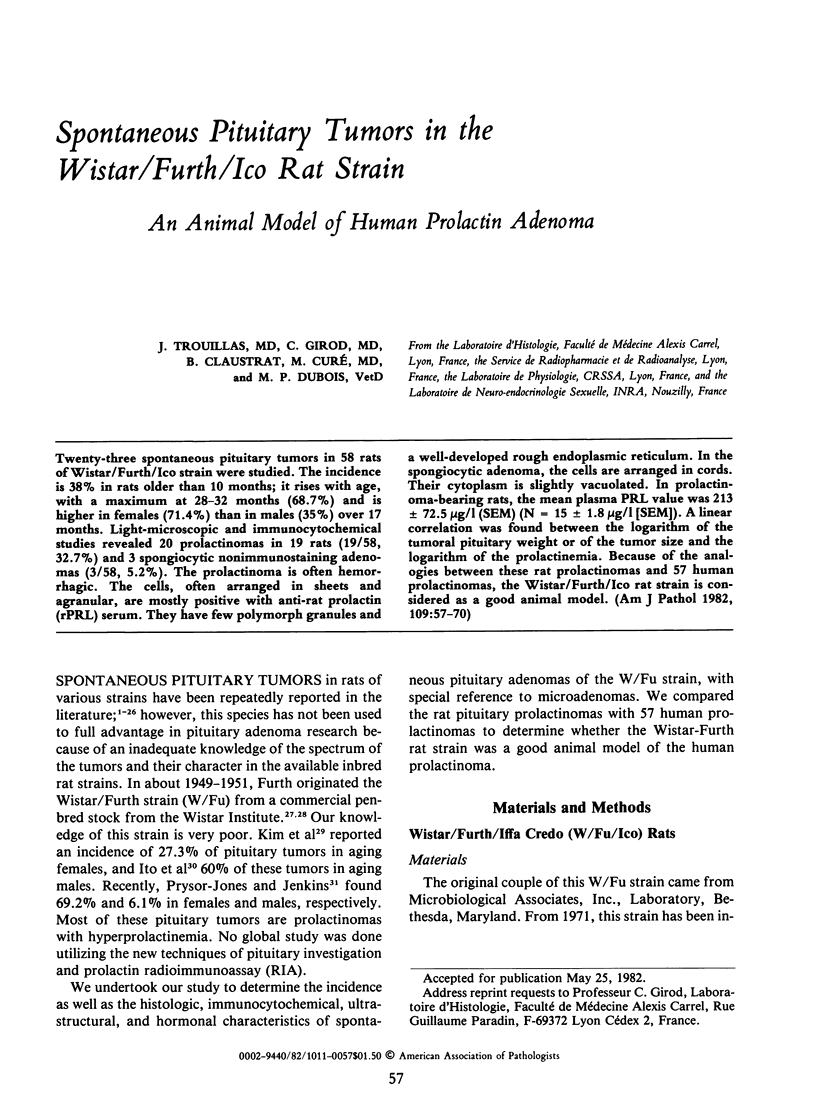
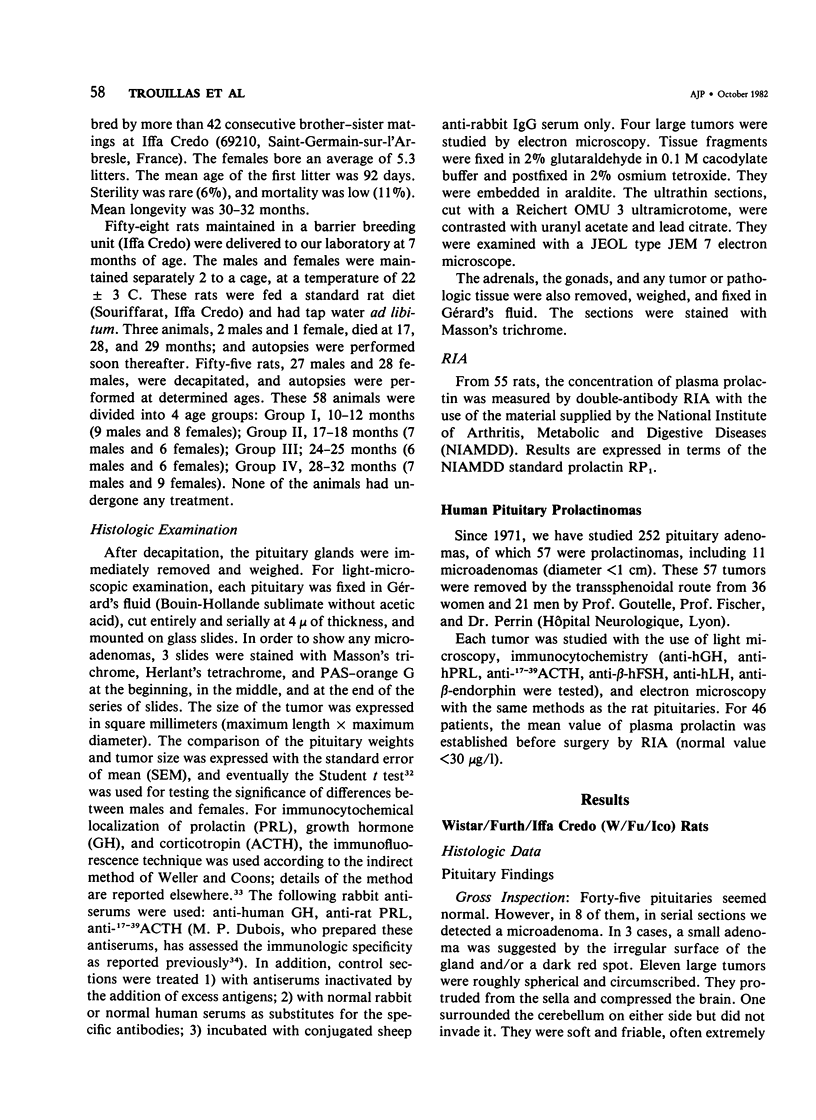
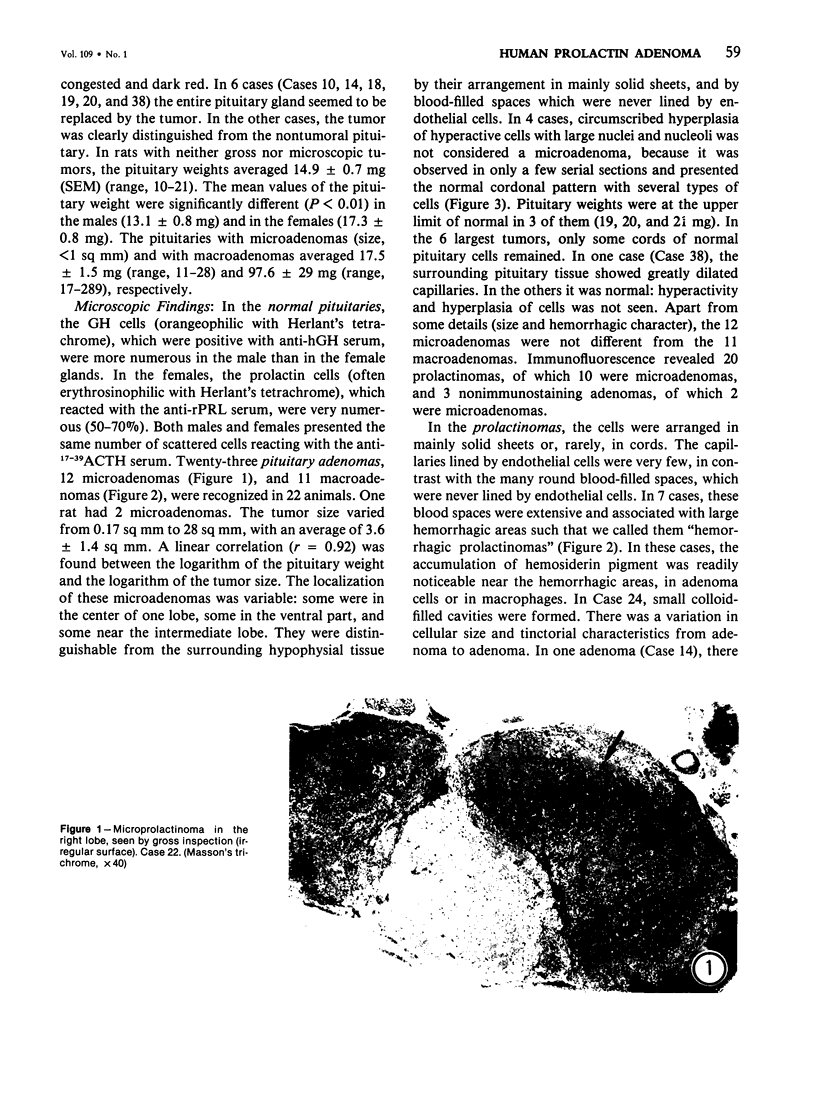
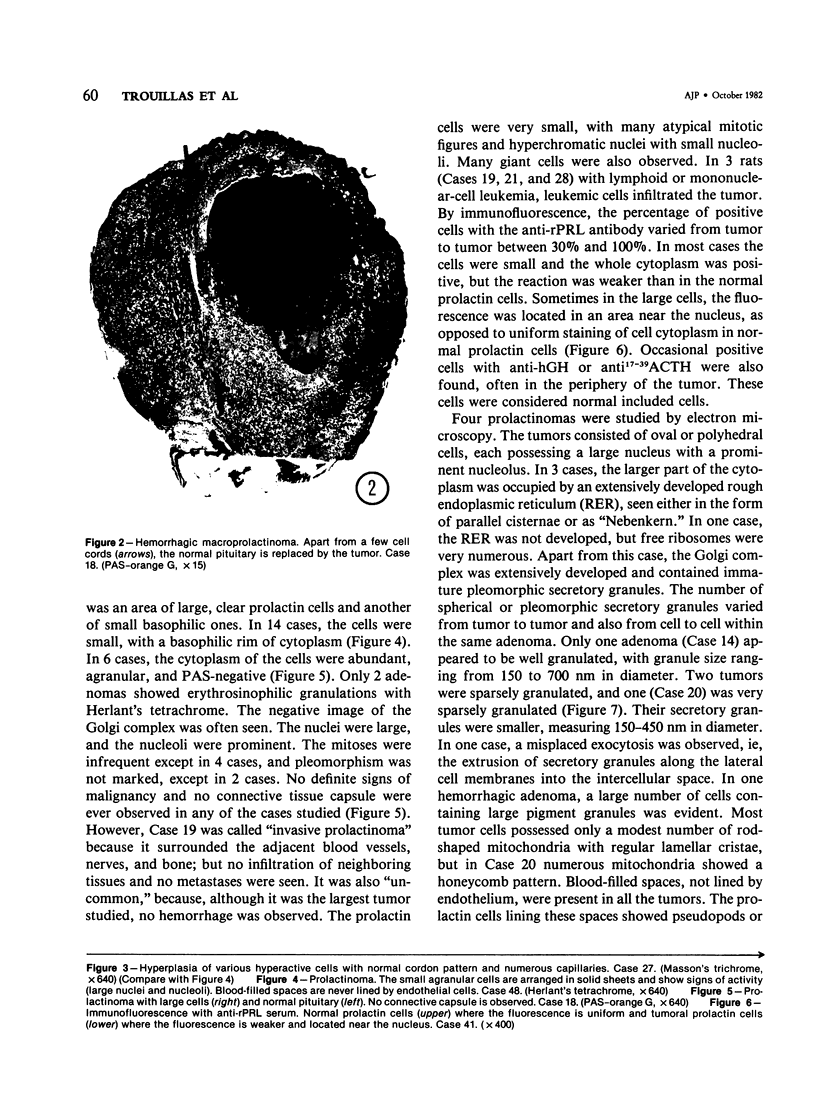
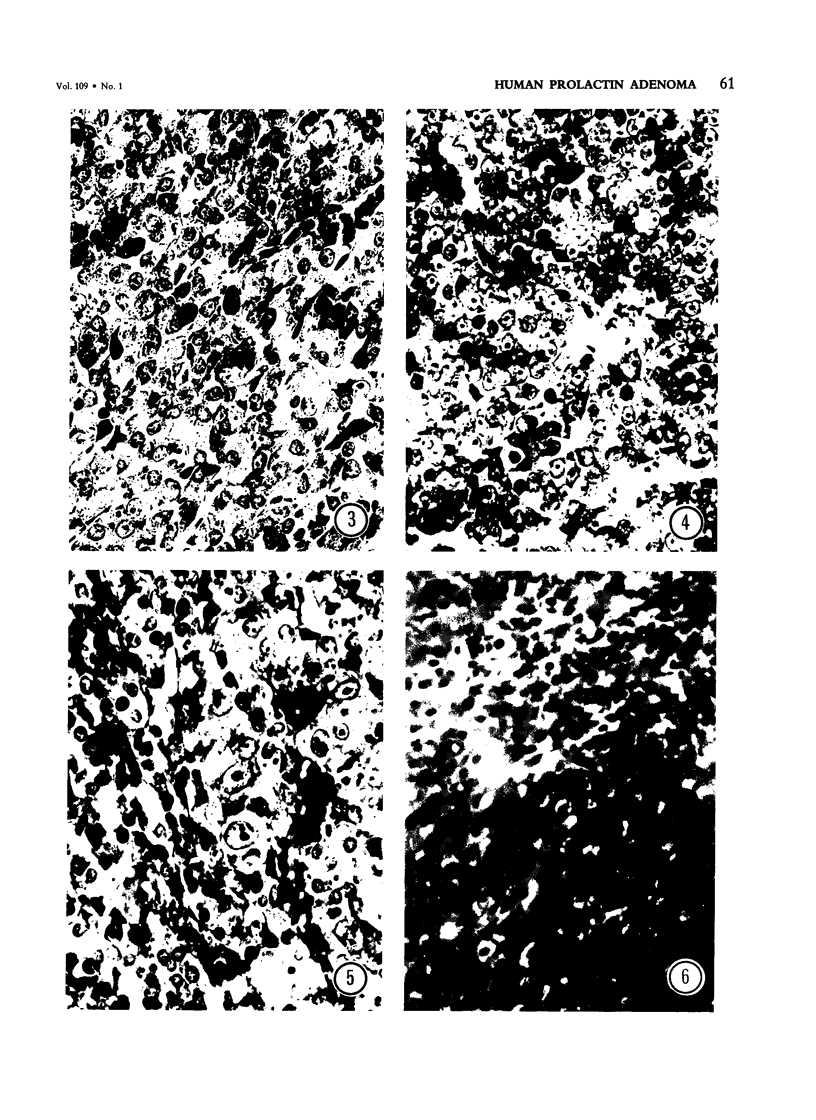
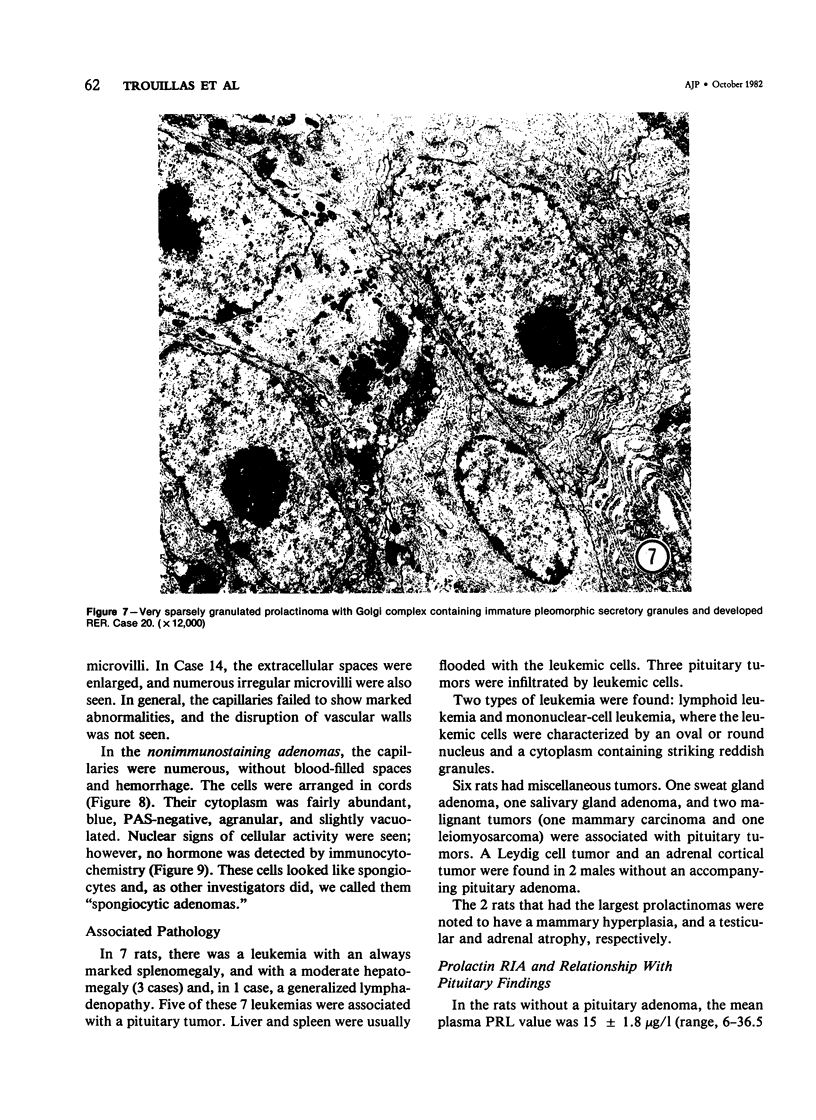
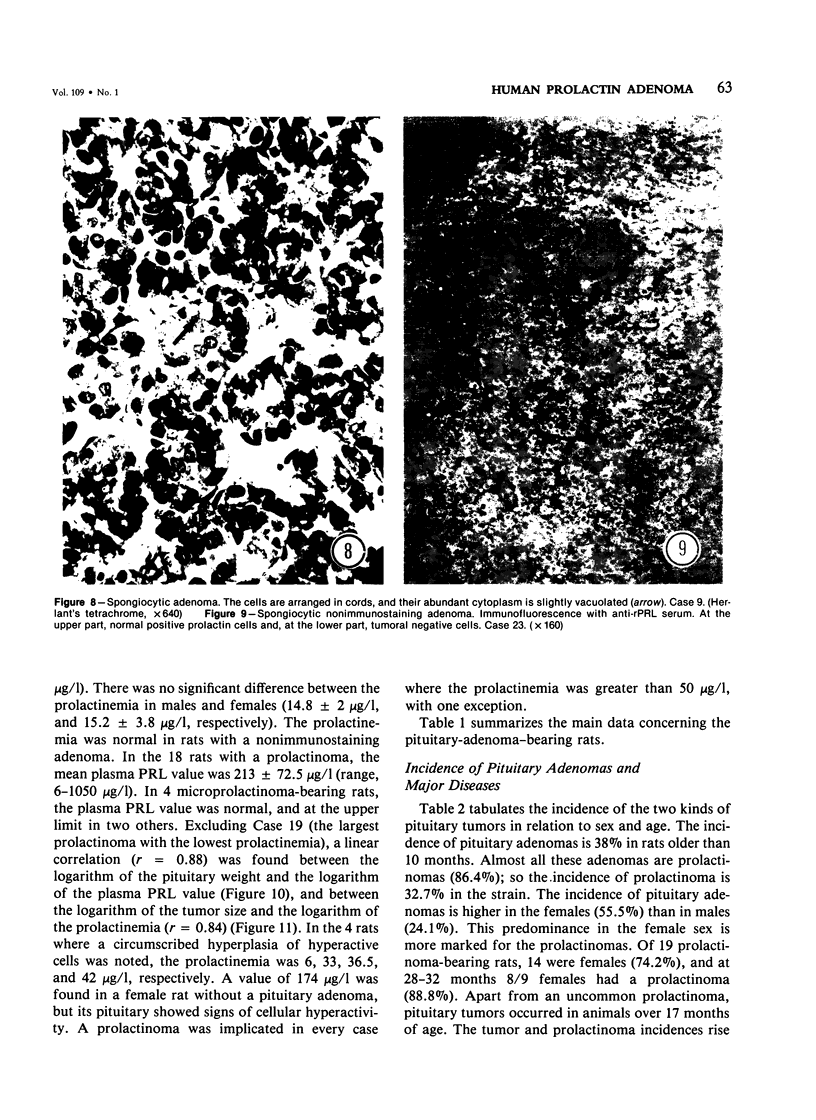
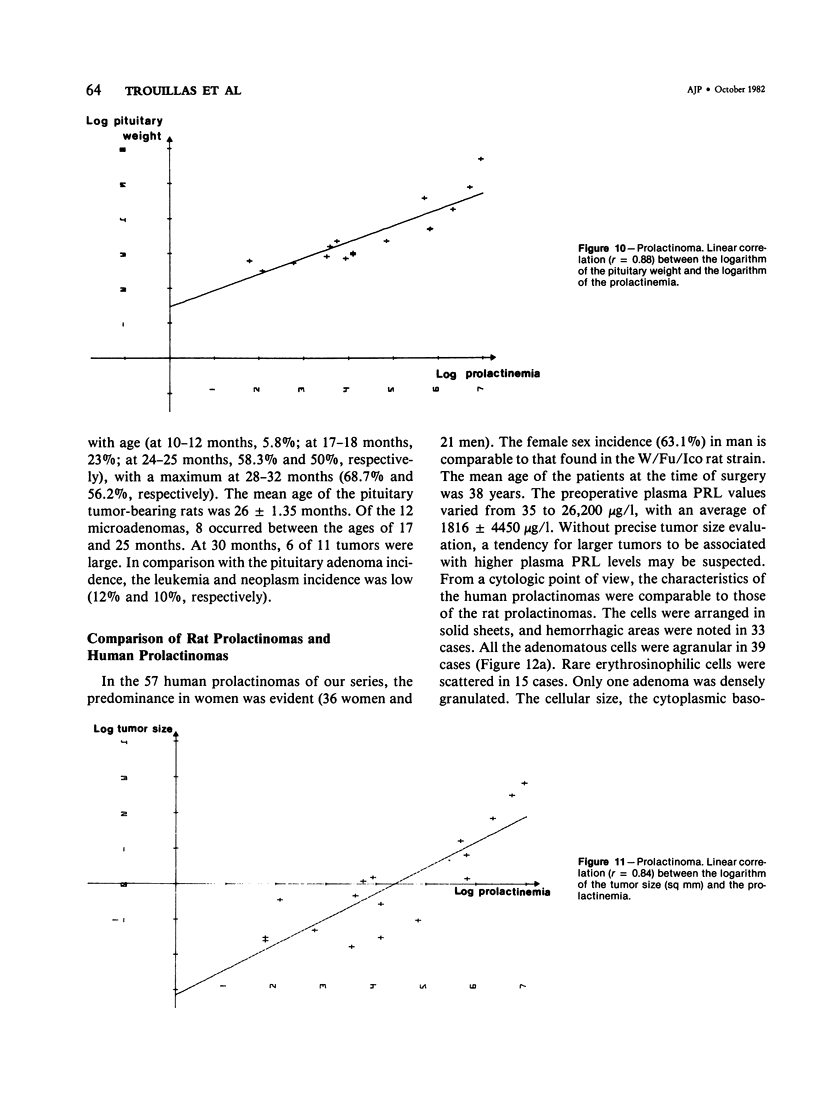
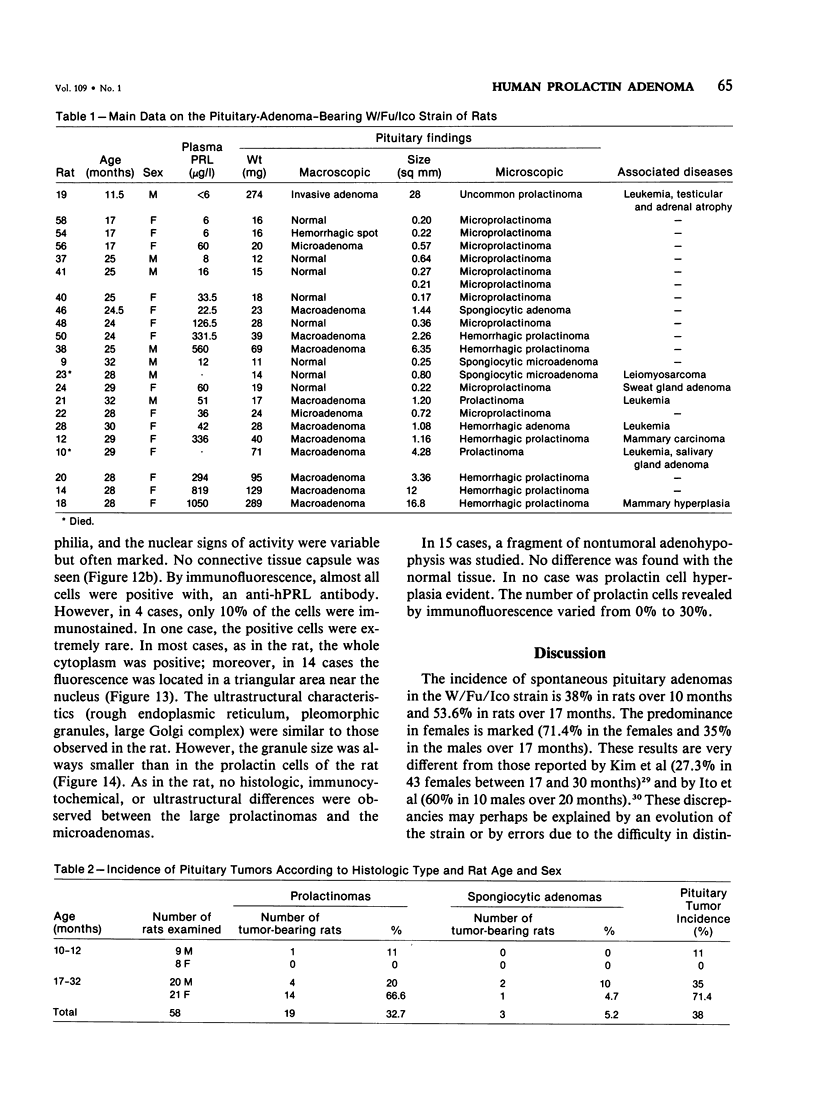
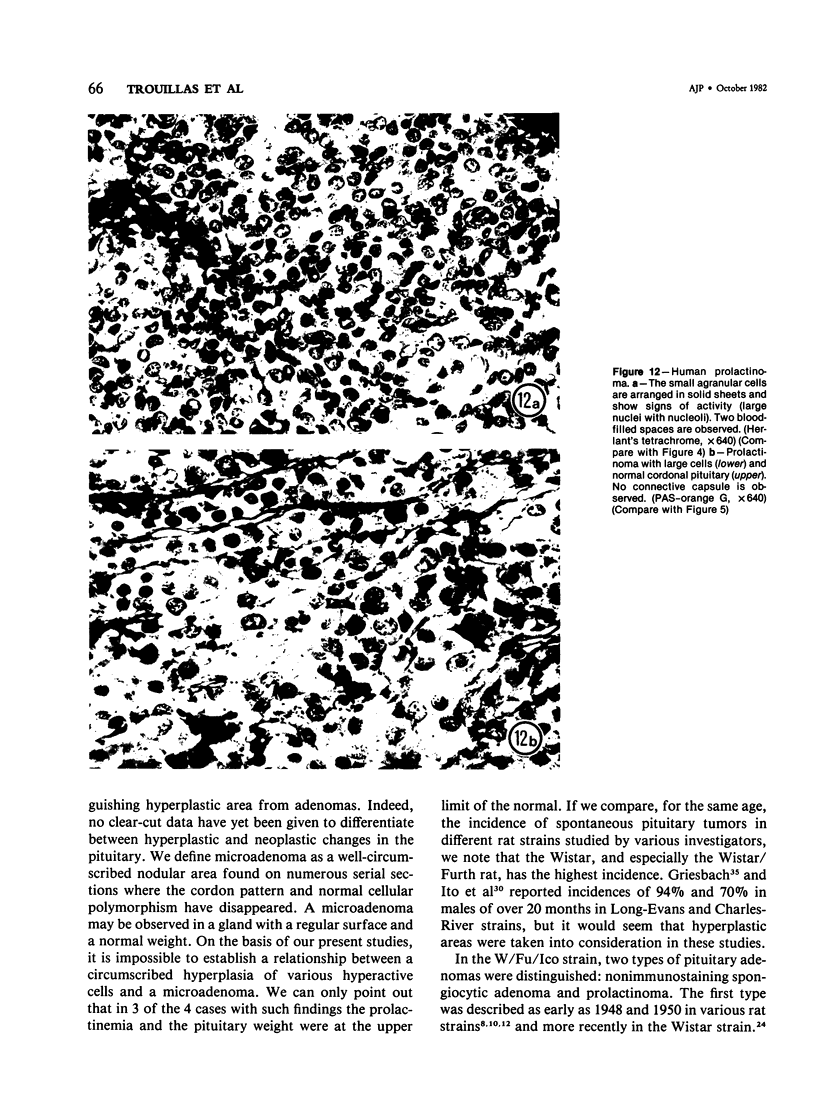
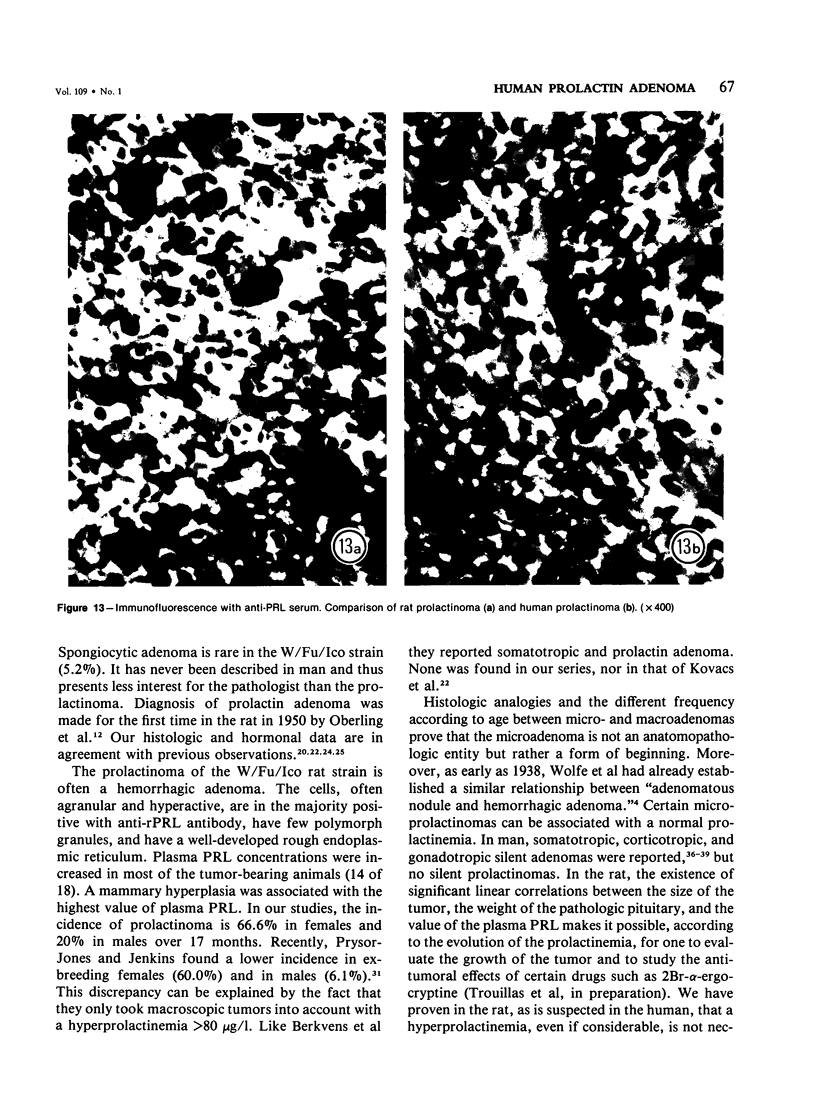
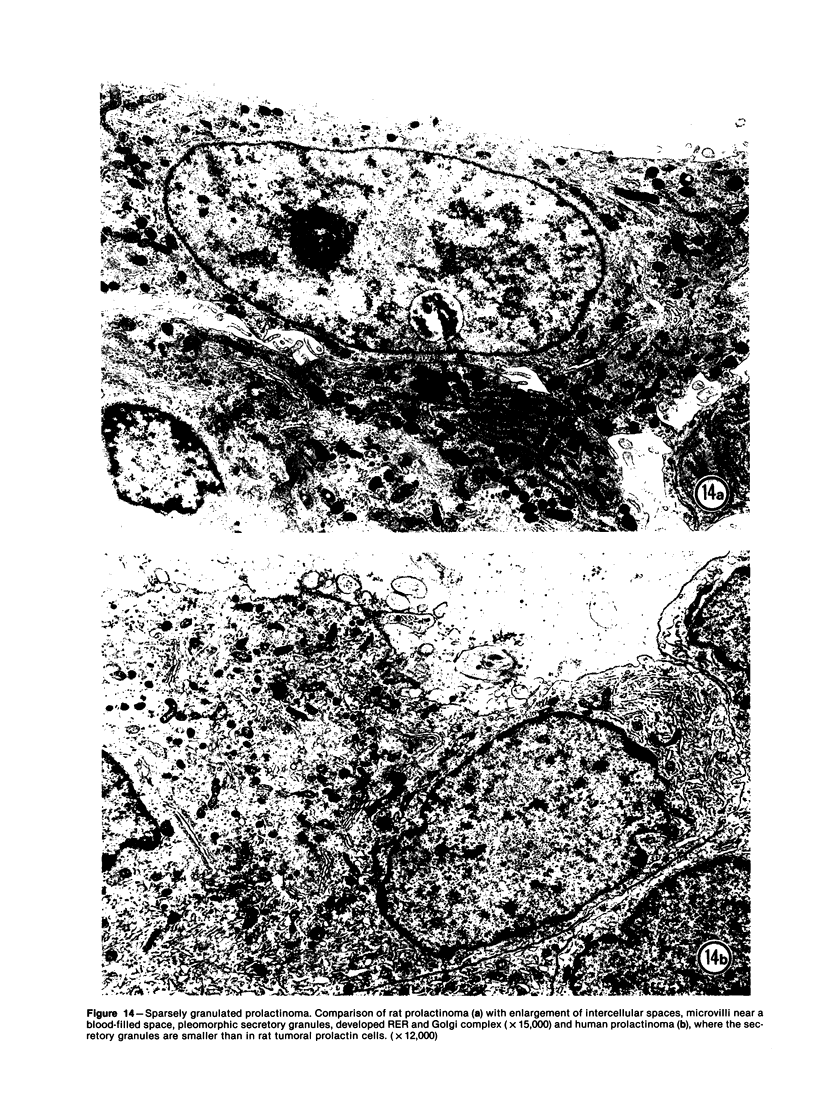
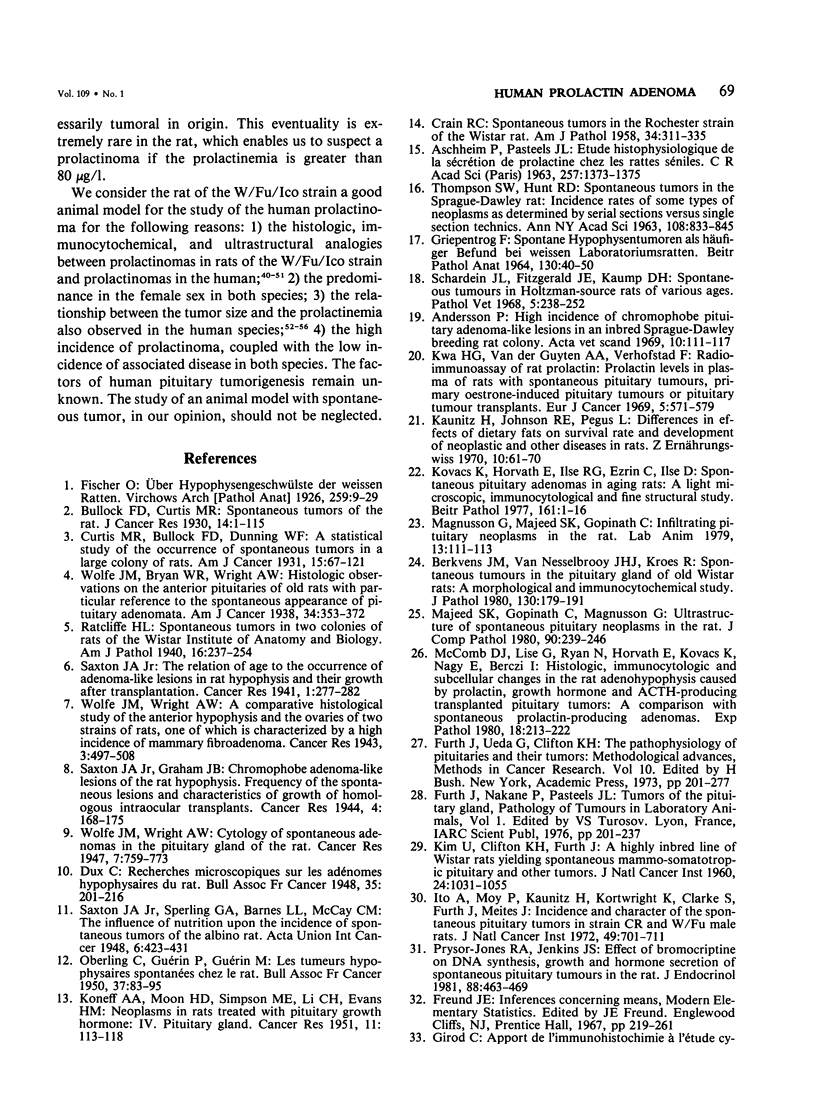
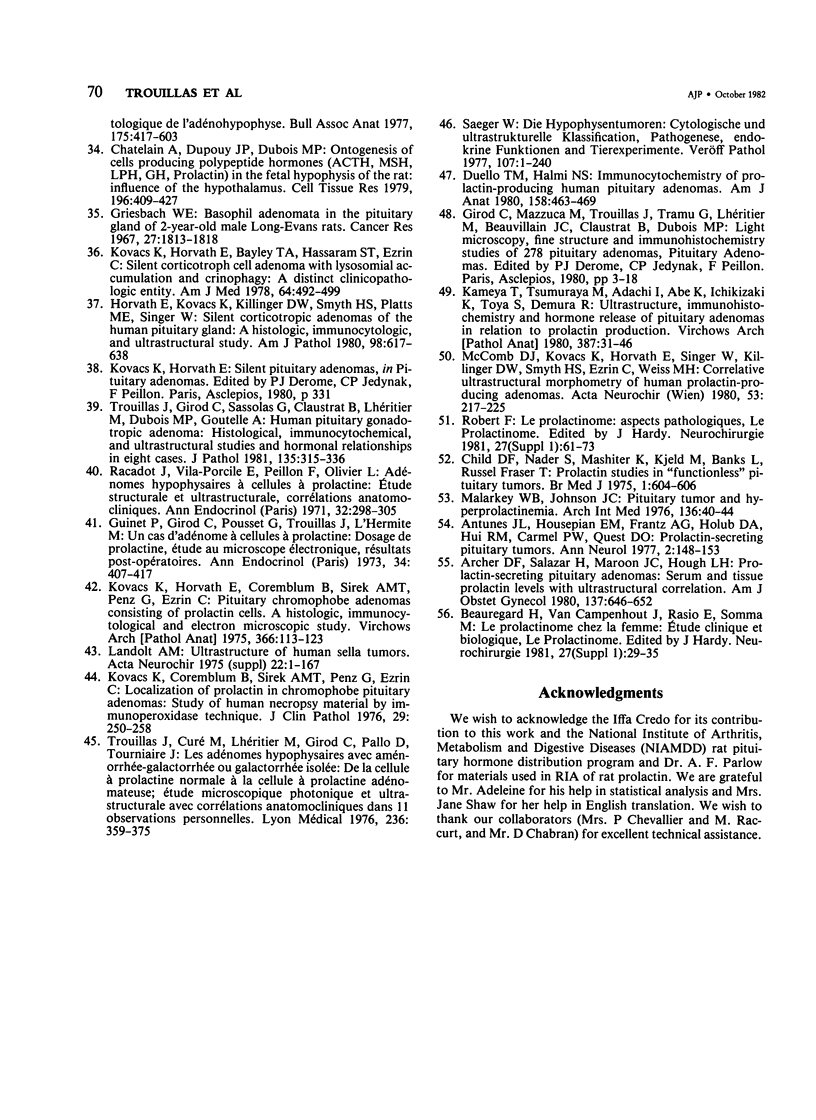
Images in this article
Selected References
These references are in PubMed. This may not be the complete list of references from this article.
- ASCHHEIM P., PASTEELS J. L. ETUDE HISTOPHYSIOLOGIQUE DE LA S'ECR'ETION DE PROLACTINE CHEZ LES RATTES S'ENILES. C R Hebd Seances Acad Sci. 1963 Aug 5;257:1373–1375. [PubMed] [Google Scholar]
- Andersson P. High incidence of chromophobe pituitary adenoma-like lesions in an inbred Sprague-Dawley breeding rat colony. Acta Vet Scand. 1969;10(2):111–117. doi: 10.1186/BF03548282. [DOI] [PMC free article] [PubMed] [Google Scholar]
- Archer D. F., Salazar H., Maroon J. C., Hough L. J. Prolactin-secreting pituitary adenomas: serum and tissue prolactin levels with ultrastructural correlation. Am J Obstet Gynecol. 1980 Jul 15;137(6):646–652. doi: 10.1016/s0002-9378(15)33236-1. [DOI] [PubMed] [Google Scholar]
- Beauregard H., Van Campenhout J., Rasio E., Somma M. Le prolactinome chez la femme. Etude clinique et biologique; évaluation préopératoire chez 200 femmes. Neurochirurgie. 1981;27 (Suppl 1):29–35. [PubMed] [Google Scholar]
- CRAIN R. C. Spontaneous tumors in the Rochester strain of the Wistar rat. Am J Pathol. 1958 Mar-Apr;34(2):311–335. [PMC free article] [PubMed] [Google Scholar]
- Chatelain A., Dupouy J. P., Dubois M. P. Ontogenesis of cells producing polypeptide hormones (ACTH, MSH, LPH, GH, prolactin) in the fetal hypophysis of the rat: influence of the hypothalamus. Cell Tissue Res. 1979 Feb 28;196(3):409–427. doi: 10.1007/BF00234737. [DOI] [PubMed] [Google Scholar]
- Child D. F., Nader S., Mashiter K., Kjeld M., Banks L., Fraser T. R. Prolactin studies in "functionless" pituitary tumours. Br Med J. 1975 Mar 15;1(5958):604–606. doi: 10.1136/bmj.1.5958.604. [DOI] [PMC free article] [PubMed] [Google Scholar]
- Duello T. M., Halmi N. S. Immunocytochemistry of prolactin-producing human pituitary adenomas. Am J Anat. 1980 Aug;158(4):463–469. doi: 10.1002/aja.1001580408. [DOI] [PubMed] [Google Scholar]
- Furth J., Nakane P., Pasteels J. L. Tumours of the pituitary gland. IARC Sci Publ. 1976;(6):201–237. [PubMed] [Google Scholar]
- GRIEPENTROG F. SPONTANE HYPOPHYSENTUMOREN ALS HAEUFIGER BEFUND BEI WEISSEN LABORATORIUMSRATTEN. Beitr Pathol Anat. 1964 Jun;130:40–50. [PubMed] [Google Scholar]
- Girod C. Apport de l'immunohistochimie à l'étude cytologique de l'adénohypophyse. Bull Assoc Anat (Nancy) 1977 Dec;62(175):417–603. [PubMed] [Google Scholar]
- Griesbach W. E. Basophil adenomata in the pituitary glands of 2-year-old male Long-Evans rats. Cancer Res. 1967 Oct;27(10):1813–1818. [PubMed] [Google Scholar]
- Guinet P., Girod C., Pousset G., Trouillas J., L'Hermite M. Un cas d'adénome á cellules á prolactine: dosage de prolactine, étude au microscope électronique, résultats post-opératoires. Ann Endocrinol (Paris) 1973 Jul-Aug;34(4):407–417. [PubMed] [Google Scholar]
- Horvath E., Kovacs K., Killinger D. W., Smyth H. S., Platts M. E., Singer W. Silent corticotropic adenomas of the human pituitary gland: a histologic, immunocytologic, and ultrastructural study. Am J Pathol. 1980 Mar;98(3):617–638. [PMC free article] [PubMed] [Google Scholar]
- Ito A., Moy P., Kaunitz H., Kortwright K., Clarke S., Furth J., Meites J. Incidence and character of the spontaneous pituitary tumors in strain CR and W-Fu male rats. J Natl Cancer Inst. 1972 Sep;49(3):701–711. [PubMed] [Google Scholar]
- KIM U., CLIFTON K. H., FURTH J. A highly inbred line of Wistar rats yielding spontaneous mammo-somatotropic pituitary and other tumors. J Natl Cancer Inst. 1960 May;24:1031–1055. [PubMed] [Google Scholar]
- KONEFF A. A., MOON H. D., SIMPSON M. E., LI C. H., EVANS H. M. Neoplasms in rats treated with pituitary growth hormone. IV. Pituitary gland. Cancer Res. 1951 Feb;11(2):113–117. [PubMed] [Google Scholar]
- Kameya T., Tsumuraya M., Adachi I., Abe K., Ichikizaki K., Toya S., Demura R. Ultrastructure, immunohistochemistry and hormone release of pituitary adenomas in relation to prolactin production. Virchows Arch A Pathol Anat Histol. 1980;387(1):31–46. doi: 10.1007/BF00428427. [DOI] [PubMed] [Google Scholar]
- Kaunitz H., Johnson R. E., Pegus L. Differences in effects of dietary fats on survival rate and development of neoplastic and other diseases in rats. Z Ernahrungswiss. 1970 Aug;10(1):61–70. doi: 10.1007/BF02027973. [DOI] [PubMed] [Google Scholar]
- Kovacs K., Corenblum B., Sirek A. M., Penz G., Ezrin C. Localization of prolactin in chromophobe pituitary adenomas: study of human necropsy material by immunoperoxidase technique. J Clin Pathol. 1976 Mar;29(3):250–258. doi: 10.1136/jcp.29.3.250. [DOI] [PMC free article] [PubMed] [Google Scholar]
- Kovacs K., Horvath E., Bayley T. A., Hassaram S. T., Ezrin C. Silent corticotroph cell adenoma with lysosomal accumulation and crinophagy. A distinct clinicopathologic entity. Am J Med. 1978 Mar;64(3):492–499. doi: 10.1016/0002-9343(78)90236-x. [DOI] [PubMed] [Google Scholar]
- Kovacs K., Horvath E., Corenblum B., Sirek A. M., Penz G., Ezrin C. Pituitary chromophobe adenomas consisting of prolactin cells: a histologic, immunocytological and electron microscopic study. Virchows Arch A Pathol Anat Histol. 1975;366(2):113–123. doi: 10.1007/BF00433585. [DOI] [PubMed] [Google Scholar]
- Kovacs K., Horvath E., Ilse R. G., Ezrin C., Ilse D. Spontaneous pituitary adenomas in aging rats. A light microscopic, immunocytological and fine structural study. Beitr Pathol. 1977 Sep;161(1):1–16. doi: 10.1016/s0005-8165(77)80106-6. [DOI] [PubMed] [Google Scholar]
- Kwa H. G., van der Gugten A. A., Verhofstad F. Radioimmunoassay of rat prolactin. Prolactin levels in plasma of rats with spontaneous pituitary tumours, primary oestrone-induced pituitary tumours or pituitary tumour transplants. Eur J Cancer. 1969 Dec;5(6):571–579. doi: 10.1016/0014-2964(69)90005-x. [DOI] [PubMed] [Google Scholar]
- Landolt A. M. Ultrastructure of human sella tumors. Correlations of clinical findings and morphology. Acta Neurochir (Wien) 1975;Suppl 22:1–167. [PubMed] [Google Scholar]
- Magnusson G., Majeed S. K., Gopinath C. Infiltrating pituitary neoplasms in the rat. Lab Anim. 1979 Apr;13(2):111–113. doi: 10.1258/002367779780943594. [DOI] [PubMed] [Google Scholar]
- Majeed S. K., Gopinath C., Magnusson G. Ultrastructure of spontaneous pituitary neoplasms in the rat. J Comp Pathol. 1980 Apr;90(2):239–246. doi: 10.1016/0021-9975(80)90060-2. [DOI] [PubMed] [Google Scholar]
- Malarkey W. B., Johnson J. C. Pituitary tumors and hyperprolactinemia. Arch Intern Med. 1976 Jan;136(1):40–44. [PubMed] [Google Scholar]
- McComb D. J., Ilse G., Ryan N., Horvath E., Kovacs K., Nagy E., Berczi I. Histologic, immunocytologic and subcellular changes in the rat adenohypophysis caused by prolactin, growth hormone and ACTH-producing transplanted pituitary tumors: a comparison with spontaneous prolactin-producing adenomas. Exp Pathol (Jena) 1980;18(4):213–222. doi: 10.1016/s0014-4908(80)80051-2. [DOI] [PubMed] [Google Scholar]
- McComb D. J., Kovacs K., Horvath E., Singer W., Killinger D. W., Smyth H. S., Ezrin C., Weiss M. H. Correlative ultrastructural morphometry of human prolactin-producing adenomas. Acta Neurochir (Wien) 1980;53(3-4):217–225. doi: 10.1007/BF02074794. [DOI] [PubMed] [Google Scholar]
- OBERLING C., GUERIN P., GUERIN M. Les tumeurs hypophysaires spontanées chez le rat. Bull Assoc Fr Etud Cancer. 1950;37(2):83–96. [PubMed] [Google Scholar]
- Prysor-Jones R. A., Jenkins J. S. Effect of bromocriptine on DNA synthesis, growth and hormone secretion of spontaneous pituitary tumours in the rat. J Endocrinol. 1981 Mar;88(3):463–469. doi: 10.1677/joe.0.0880463. [DOI] [PubMed] [Google Scholar]
- Ratcliffe H. L. Spontaneous tumors in two colonies of rats of the Wistar Institute of Anatomy and Biology. Am J Pathol. 1940 May;16(3):237–254.1. [PMC free article] [PubMed] [Google Scholar]
- Robert F. Le prolactinome: aspects pathologiques. Neurochirurgie. 1981;27 (Suppl 1):61–73. [PubMed] [Google Scholar]
- Saeger W. Die Hypophysentumoren. Cytologische und ultrastrukturelle Klassifikation, Pathogenese, endokrine Funktionen und Tierexperimente. Veroff Pathol. 1977;(107):1–240. [PubMed] [Google Scholar]
- Schardein J. L., Fitzgerald J. E., Kaump D. H. Spontaneous tumors in Holtzman-source rats of various ages. Pathol Vet. 1968;5(3):238–252. doi: 10.1177/030098586800500305. [DOI] [PubMed] [Google Scholar]
- THOMPSON S. W., HUNT R. D. SPONTANEOUS TUMORS IN THE SPRAGUE-DAWLEY RAT: INCIDENCE RATES OF SOME TYPES OF NEOPLASMS AS DETERMINED BY SERIAL SECTION VERSUS SINGLE SECTION TECHNICS. Ann N Y Acad Sci. 1963 Nov 4;108:833–845. doi: 10.1111/j.1749-6632.1963.tb13422.x. [DOI] [PubMed] [Google Scholar]
- Trouillas J., Girod C., Sassolas G., Claustrat B., Lhéritier M., Dubois M. P., Goutelle A. Human pituitary gonadotropic adenoma; histological, immunocytochemical, and ultrastructural and hormonal studies in eight cases. J Pathol. 1981 Dec;135(4):315–336. doi: 10.1002/path.1711350408. [DOI] [PubMed] [Google Scholar]



